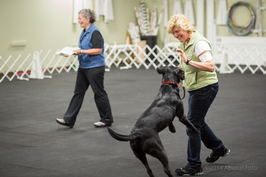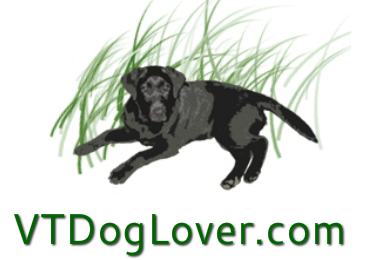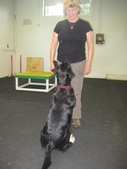
“Training for attitude: some lessons learned …”
To me, few things are more awe-inspiring than a flawlessly choreographed performance in competition obedience. The sight of a dog and handler moving together with style and fluidity is poetry in motion. Contrast that picture to one in which the dog goes through the motions of the exercises by rote, without enjoyment or energy. The handler’s body language may be similarly uninspired or may even convey frustration, disgust or despair. The dog may “do” everything, but there is no spark.
Attitude -- of confident eagerness for the work -- can change a precise performance from robotic to riveting.
In some dog sports, eagerness may come naturally -- herding for herding dogs, field work for retrievers, agility for many dogs, K9 Nosework for most dogs! It’s a rare gem of a dog who has a natural and sustained eagerness for competition obedience over a full career.
Success in competition obedience is a marathon, not a sprint. Over time, one can fall into some common traps that can drain the dog (and handler!) of attitude and enthusiasm. Repetitive and/or overly long training sessions; too much formal “testing” (in place of training); a consistent focus on problems rather than achievements; training when the dog is exhausted, under the weather, etc.; letting the dog get things wrong too many times in a row: such things can sneak up until one day, we notice our once eager dog is slow, dull, lagging, scratching, balking, inattentive, clingy, or just plain quitting on us.
Following are some suggestions based on my experience. The list is hardly exhaustive and will be a reminder for most long-timers, but I hope it will spare some newer enthusiasts and their dogs some angst and retraining!
Train a dog who is eager to train! Sounds obvious, but it’s easy to get in a rush and forget to adequately prepare the dog mentally or physically before starting the session. Take a few moments to play together. Do some food toss recalls. Ask for some tricks or a favorite behavior. Do what it takes to get your dog engaged with you from the get go.
Actively train attitude – drive, speed, even specific body affect like head up or ears forward – in addition to precision. By rewarding slow, laggy behavior, even if it’s technically “correct,” you can inadvertently train a slow, dull response! Of course, your dog may perform slowly as he’s first learning a new task, but once the mechanics are in place, get him working briskly. (Note how many times “brisk” is noted as a requirement in the regulations!)
Train, don’t nitpick or nag. If the dog “fails” at something twice in a row in a session, take the exercise apart, analyze the pieces, find out what’s broken or unclear, and help the dog get back on track. Don’t be afraid to go all the way back to square one if need be.
But don’t stay too long at one level or make things too easy, either! Dogs, like people, can get bored by too many easy repetitions. Challenge the dog… thoughtfully and fairly .. to do better, as you would challenge yourself.
Focus on successes; plan for problems. If we focus too much on what’s wrong rather than right, the attitude of both dog and handler will suffer.
Quit while the dog is eager for more. Avoid the “just one more” syndrome. Several short sessions are better than one long one.
Break things up during the session. After a few good training minutes, break it off and play tug, toss a ball, run together, etc. Keep the dog guessing and the distinction between play and work will largely disappear.
Vary your rewards. If you usually hand your dog a treat, roll the treat on the ground and say, “find it!” instead. Toss the ball through your legs rather than away from you. Give 5 tiny treats in a row, making a big fuss over each one. Break off and run around the yard with the dog. Variety helps keep the session fun and interesting for both of you.
Plan your sessions and keep a training log. Not only will you stay honest about what your dog really knows, you’ll clearly see your progress over time.
Trial when you’re ready, not before. The stress of trials does strange things to handlers and dogs! Make sure your training is rock solid and your proofing is iron clad before entering the ring for real.
Cross train with your dog. Doing other dog sports can enhance your relationship, improve your dog’s attitude toward training, and take the pressure off for both of you.
Finally, if your attitude is bad – if you’re mad, frustrated, etc. – put your dog away and train another time. OR train anyway, and double the rewards you give the dog for hanging in there with you!
Happy training!
To me, few things are more awe-inspiring than a flawlessly choreographed performance in competition obedience. The sight of a dog and handler moving together with style and fluidity is poetry in motion. Contrast that picture to one in which the dog goes through the motions of the exercises by rote, without enjoyment or energy. The handler’s body language may be similarly uninspired or may even convey frustration, disgust or despair. The dog may “do” everything, but there is no spark.
Attitude -- of confident eagerness for the work -- can change a precise performance from robotic to riveting.
In some dog sports, eagerness may come naturally -- herding for herding dogs, field work for retrievers, agility for many dogs, K9 Nosework for most dogs! It’s a rare gem of a dog who has a natural and sustained eagerness for competition obedience over a full career.
Success in competition obedience is a marathon, not a sprint. Over time, one can fall into some common traps that can drain the dog (and handler!) of attitude and enthusiasm. Repetitive and/or overly long training sessions; too much formal “testing” (in place of training); a consistent focus on problems rather than achievements; training when the dog is exhausted, under the weather, etc.; letting the dog get things wrong too many times in a row: such things can sneak up until one day, we notice our once eager dog is slow, dull, lagging, scratching, balking, inattentive, clingy, or just plain quitting on us.
Following are some suggestions based on my experience. The list is hardly exhaustive and will be a reminder for most long-timers, but I hope it will spare some newer enthusiasts and their dogs some angst and retraining!
Train a dog who is eager to train! Sounds obvious, but it’s easy to get in a rush and forget to adequately prepare the dog mentally or physically before starting the session. Take a few moments to play together. Do some food toss recalls. Ask for some tricks or a favorite behavior. Do what it takes to get your dog engaged with you from the get go.
Actively train attitude – drive, speed, even specific body affect like head up or ears forward – in addition to precision. By rewarding slow, laggy behavior, even if it’s technically “correct,” you can inadvertently train a slow, dull response! Of course, your dog may perform slowly as he’s first learning a new task, but once the mechanics are in place, get him working briskly. (Note how many times “brisk” is noted as a requirement in the regulations!)
Train, don’t nitpick or nag. If the dog “fails” at something twice in a row in a session, take the exercise apart, analyze the pieces, find out what’s broken or unclear, and help the dog get back on track. Don’t be afraid to go all the way back to square one if need be.
But don’t stay too long at one level or make things too easy, either! Dogs, like people, can get bored by too many easy repetitions. Challenge the dog… thoughtfully and fairly .. to do better, as you would challenge yourself.
Focus on successes; plan for problems. If we focus too much on what’s wrong rather than right, the attitude of both dog and handler will suffer.
Quit while the dog is eager for more. Avoid the “just one more” syndrome. Several short sessions are better than one long one.
Break things up during the session. After a few good training minutes, break it off and play tug, toss a ball, run together, etc. Keep the dog guessing and the distinction between play and work will largely disappear.
Vary your rewards. If you usually hand your dog a treat, roll the treat on the ground and say, “find it!” instead. Toss the ball through your legs rather than away from you. Give 5 tiny treats in a row, making a big fuss over each one. Break off and run around the yard with the dog. Variety helps keep the session fun and interesting for both of you.
Plan your sessions and keep a training log. Not only will you stay honest about what your dog really knows, you’ll clearly see your progress over time.
Trial when you’re ready, not before. The stress of trials does strange things to handlers and dogs! Make sure your training is rock solid and your proofing is iron clad before entering the ring for real.
Cross train with your dog. Doing other dog sports can enhance your relationship, improve your dog’s attitude toward training, and take the pressure off for both of you.
Finally, if your attitude is bad – if you’re mad, frustrated, etc. – put your dog away and train another time. OR train anyway, and double the rewards you give the dog for hanging in there with you!
Happy training!


 RSS Feed
RSS Feed